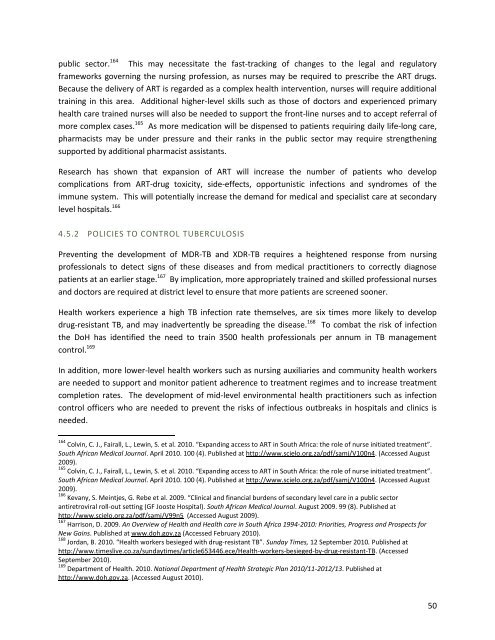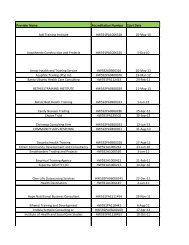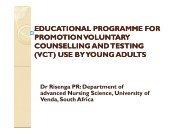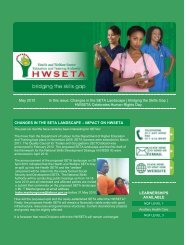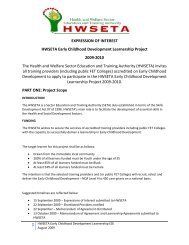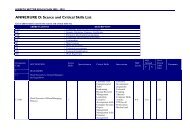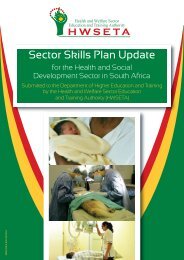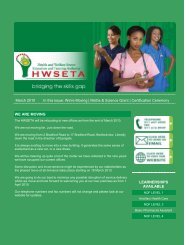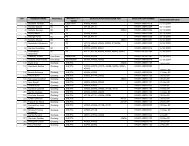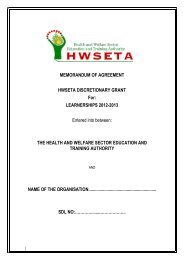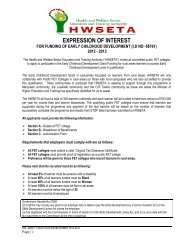sector skills plan for the health sector in south africa
sector skills plan for the health sector in south africa
sector skills plan for the health sector in south africa
Create successful ePaper yourself
Turn your PDF publications into a flip-book with our unique Google optimized e-Paper software.
public <strong>sector</strong>. 164 This may necessitate <strong>the</strong> fast-track<strong>in</strong>g of changes to <strong>the</strong> legal and regulatory<br />
frameworks govern<strong>in</strong>g <strong>the</strong> nurs<strong>in</strong>g profession, as nurses may be required to prescribe <strong>the</strong> ART drugs.<br />
Because <strong>the</strong> delivery of ART is regarded as a complex <strong>health</strong> <strong>in</strong>tervention, nurses will require additional<br />
tra<strong>in</strong><strong>in</strong>g <strong>in</strong> this area. Additional higher-level <strong>skills</strong> such as those of doctors and experienced primary<br />
<strong>health</strong> care tra<strong>in</strong>ed nurses will also be needed to support <strong>the</strong> front-l<strong>in</strong>e nurses and to accept referral of<br />
more complex cases. 165 As more medication will be dispensed to patients requir<strong>in</strong>g daily life-long care,<br />
pharmacists may be under pressure and <strong>the</strong>ir ranks <strong>in</strong> <strong>the</strong> public <strong>sector</strong> may require streng<strong>the</strong>n<strong>in</strong>g<br />
supported by additional pharmacist assistants.<br />
Research has shown that expansion of ART will <strong>in</strong>crease <strong>the</strong> number of patients who develop<br />
complications from ART-drug toxicity, side-effects, opportunistic <strong>in</strong>fections and syndromes of <strong>the</strong><br />
immune system. This will potentially <strong>in</strong>crease <strong>the</strong> demand <strong>for</strong> medical and specialist care at secondary<br />
level hospitals. 166<br />
4.5.2 POLICIES TO CONTROL TUBERCULOSIS<br />
Prevent<strong>in</strong>g <strong>the</strong> development of MDR-TB and XDR-TB requires a heightened response from nurs<strong>in</strong>g<br />
professionals to detect signs of <strong>the</strong>se diseases and from medical practitioners to correctly diagnose<br />
patients at an earlier stage. 167 By implication, more appropriately tra<strong>in</strong>ed and skilled professional nurses<br />
and doctors are required at district level to ensure that more patients are screened sooner.<br />
Health workers experience a high TB <strong>in</strong>fection rate <strong>the</strong>mselves, are six times more likely to develop<br />
drug-resistant TB, and may <strong>in</strong>advertently be spread<strong>in</strong>g <strong>the</strong> disease. 168 To combat <strong>the</strong> risk of <strong>in</strong>fection<br />
<strong>the</strong> DoH has identified <strong>the</strong> need to tra<strong>in</strong> 3500 <strong>health</strong> professionals per annum <strong>in</strong> TB management<br />
control. 169<br />
In addition, more lower-level <strong>health</strong> workers such as nurs<strong>in</strong>g auxiliaries and community <strong>health</strong> workers<br />
are needed to support and monitor patient adherence to treatment regimes and to <strong>in</strong>crease treatment<br />
completion rates. The development of mid-level environmental <strong>health</strong> practitioners such as <strong>in</strong>fection<br />
control officers who are needed to prevent <strong>the</strong> risks of <strong>in</strong>fectious outbreaks <strong>in</strong> hospitals and cl<strong>in</strong>ics is<br />
needed.<br />
164 Colv<strong>in</strong>, C. J., Fairall, L., Lew<strong>in</strong>, S. et al. 2010. “Expand<strong>in</strong>g access to ART <strong>in</strong> South Africa: <strong>the</strong> role of nurse <strong>in</strong>itiated treatment”.<br />
South African Medical Journal. April 2010. 100 (4). Published at http://www.scielo.org.za/pdf/samj/V100n4. (Accessed August<br />
2009).<br />
165 Colv<strong>in</strong>, C. J., Fairall, L., Lew<strong>in</strong>, S. et al. 2010. “Expand<strong>in</strong>g access to ART <strong>in</strong> South Africa: <strong>the</strong> role of nurse <strong>in</strong>itiated treatment”.<br />
South African Medical Journal. April 2010. 100 (4). Published at http://www.scielo.org.za/pdf/samj/V100n4. (Accessed August<br />
2009).<br />
166 Kevany, S. Me<strong>in</strong>tjes, G. Rebe et al. 2009. “Cl<strong>in</strong>ical and f<strong>in</strong>ancial burdens of secondary level care <strong>in</strong> a public <strong>sector</strong><br />
antiretroviral roll-out sett<strong>in</strong>g (GF Jooste Hospital). South African Medical Journal. August 2009. 99 (8). Published at<br />
http://www.scielo.org.za/pdf/samj/V99n5 (Accessed August 2009).<br />
167 Harrison, D. 2009. An Overview of Health and Health care <strong>in</strong> South Africa 1994-2010: Priorities, Progress and Prospects <strong>for</strong><br />
New Ga<strong>in</strong>s. Published at www.doh.gov.za (Accessed February 2010).<br />
168 Jordan, B. 2010. “Health workers besieged with drug-resistant TB”. Sunday Times, 12 September 2010. Published at<br />
http://www.timeslive.co.za/sundaytimes/article653446.ece/Health-workers-besieged-by-drug-resistant-TB. (Accessed<br />
September 2010).<br />
169 Department of Health. 2010. National Department of Health Strategic Plan 2010/11-2012/13. Published at<br />
http://www.doh.gov.za. (Accessed August 2010).<br />
50


